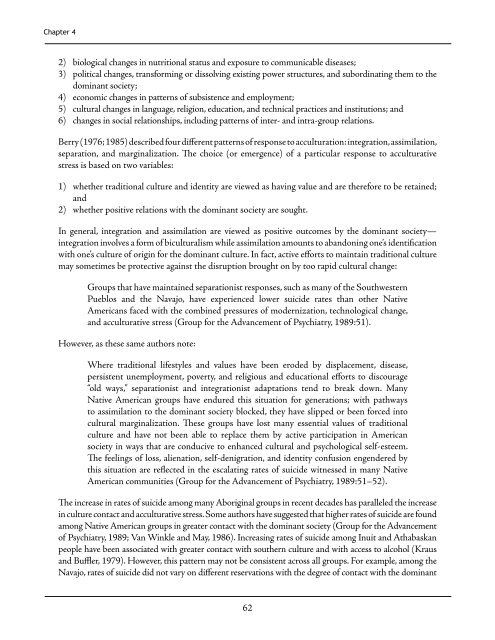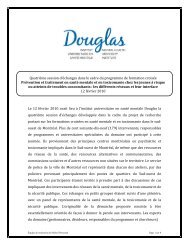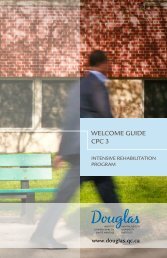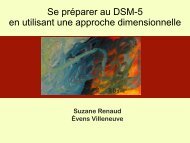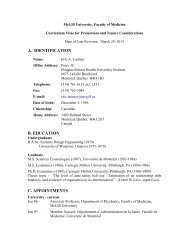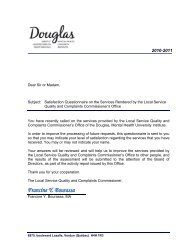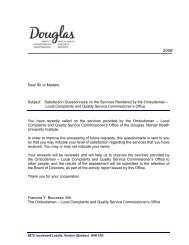Chapter 4are equivalent <strong>in</strong> seriousness to the loss of social role and status <strong>in</strong> a large-scale urban society or to afarmer’s loss of land, which simultaneously threatens both livelihood and identity. The result is certa<strong>in</strong>lya potential loss of self-esteem, but also the underm<strong>in</strong><strong>in</strong>g of a dist<strong>in</strong>ctive form of identity and self-efficacythat has to do with liv<strong>in</strong>g on and through the land (Brody, 1975; 2000). The implication is that issuesthat may seem purely political or territorial for the dom<strong>in</strong>ant society may be fundamental issues ofcollective and personal identity and well-be<strong>in</strong>g for some <strong>Aborig<strong>in</strong>al</strong> <strong>in</strong>dividuals and communities.Culture Change, Modernization, and AcculturationI believe that culture is very important for each <strong>in</strong>dividual <strong>in</strong> the community becauseof identity? Like I was raised many years ago and I felt like I’m caught between twocultures. And when you look at it <strong>in</strong> a positive way, its good to know both sides, but itwas very important to me to f<strong>in</strong>d out where I came from and have an identity. And haveknowledge about my culture and get rooted. You know, to get rooted where I could standup and say “this is me” and be proud of it. And you f<strong>in</strong>d a lot of students— I’m a schoolcounsellor at home so I dealt with a lot of people, a lot of teens and students—identity’sa big problem and culture ... is very important ... culture is very important for them tomake a stand and have an identity. And that’s what helps with suicide — to know whoyou are and not be mixed up or <strong>in</strong> between or someth<strong>in</strong>g where you can’t f<strong>in</strong>d your ownbalance (First Nation adult).For <strong>Aborig<strong>in</strong>al</strong> people, cultural change has been driven both by their own economic <strong>in</strong>terests and bytremendous external pressure from government, economic, educational, medical, and religious <strong>in</strong>stitutionsat various po<strong>in</strong>ts of their history (Adams, 1989; Berger, 1991; Crowe, 1991; Dickason, 1992; Miller, 2000;Moore, 1993; Satzewich and Wotherspoon, 1993; York, 1990). This process of cultural confrontationand change has usually proceeded at a pace dictated by <strong>in</strong>terests outside the <strong>Aborig<strong>in</strong>al</strong> communities.Changes have been particularly profound for <strong>Aborig<strong>in</strong>al</strong> groups that were hunter-gatherer societiesorganized at the level of extended family, clans, bands, or tribes. In most cases, these groups wereaccustomed to mobility across large territories with low population densities and relatively unstructuredsocial systems. The process of sedentarization has changed all of these dimensions of traditional life.Communities of several hundred or a few thousand unrelated <strong>in</strong>dividuals liv<strong>in</strong>g <strong>in</strong> overcrowded dwell<strong>in</strong>gswith complicated new political and bureaucratic <strong>in</strong>stitutions that restrict freedom of activity are nowthe reality for most <strong>Aborig<strong>in</strong>al</strong> people. These changes have disrupted traditional roles, identities, andpatterns of <strong>in</strong>teraction and support as well as social networks. Increas<strong>in</strong>g rates of suicide and other socialand psychological problems among Indigenous people worldwide have been attributed to such changes(Le<strong>in</strong>eweber et al., 2001; Le<strong>in</strong>eweber and Arensman, 2003).Acculturation“Acculturation” is a term for the accommodation of <strong>in</strong>dividuals from one cultural background to theencounter with a new culture. Berry (1993) notes that at the level of the group, acculturation may <strong>in</strong>volvemany types of changes:1) changes <strong>in</strong> physical environment <strong>in</strong>clud<strong>in</strong>g location, hous<strong>in</strong>g, population density, urbanization,environmental degradation, and pollution;61
Chapter 42) biological changes <strong>in</strong> nutritional status and exposure to communicable diseases;3) political changes, transform<strong>in</strong>g or dissolv<strong>in</strong>g exist<strong>in</strong>g power structures, and subord<strong>in</strong>at<strong>in</strong>g them to thedom<strong>in</strong>ant society;4) economic changes <strong>in</strong> patterns of subsistence and employment;5) cultural changes <strong>in</strong> language, religion, education, and technical practices and <strong>in</strong>stitutions; and6) changes <strong>in</strong> social relationships, <strong>in</strong>clud<strong>in</strong>g patterns of <strong>in</strong>ter- and <strong>in</strong>tra-group relations.Berry (1976; 1985) described four different patterns of response to acculturation: <strong>in</strong>tegration, assimilation,separation, and marg<strong>in</strong>alization. The choice (or emergence) of a particular response to acculturativestress is based on two variables:1) whether traditional culture and identity are viewed as hav<strong>in</strong>g value and are therefore to be reta<strong>in</strong>ed;and2) whether positive relations with the dom<strong>in</strong>ant society are sought.In general, <strong>in</strong>tegration and assimilation are viewed as positive outcomes by the dom<strong>in</strong>ant society—<strong>in</strong>tegration <strong>in</strong>volves a form of biculturalism while assimilation amounts to abandon<strong>in</strong>g one’s identificationwith one’s culture of orig<strong>in</strong> for the dom<strong>in</strong>ant culture. In fact, active efforts to ma<strong>in</strong>ta<strong>in</strong> traditional culturemay sometimes be protective aga<strong>in</strong>st the disruption brought on by too rapid cultural change:Groups that have ma<strong>in</strong>ta<strong>in</strong>ed separationist responses, such as many of the SouthwesternPueblos and the Navajo, have experienced lower suicide rates than other NativeAmericans faced with the comb<strong>in</strong>ed pressures of modernization, technological change,and acculturative stress (Group for the Advancement of Psychiatry, 1989:51).However, as these same authors note:Where traditional lifestyles and values have been eroded by displacement, disease,persistent unemployment, poverty, and religious and educational efforts to discourage“old ways,” separationist and <strong>in</strong>tegrationist adaptations tend to break down. ManyNative American groups have endured this situation for generations; with pathwaysto assimilation to the dom<strong>in</strong>ant society blocked, they have slipped or been forced <strong>in</strong>tocultural marg<strong>in</strong>alization. These groups have lost many essential values of traditionalculture and have not been able to replace them by active participation <strong>in</strong> Americansociety <strong>in</strong> ways that are conducive to enhanced cultural and psychological self-esteem.The feel<strong>in</strong>gs of loss, alienation, self-denigration, and identity confusion engendered bythis situation are reflected <strong>in</strong> the escalat<strong>in</strong>g rates of suicide witnessed <strong>in</strong> many NativeAmerican communities (Group for the Advancement of Psychiatry, 1989:51–52).The <strong>in</strong>crease <strong>in</strong> rates of suicide among many <strong>Aborig<strong>in</strong>al</strong> groups <strong>in</strong> recent decades has paralleled the <strong>in</strong>crease<strong>in</strong> culture contact and acculturative stress. Some authors have suggested that higher rates of suicide are foundamong Native American groups <strong>in</strong> greater contact with the dom<strong>in</strong>ant society (Group for the Advancementof Psychiatry, 1989; Van W<strong>in</strong>kle and May, 1986). Increas<strong>in</strong>g rates of suicide among Inuit and Athabaskanpeople have been associated with greater contact with southern culture and with access to alcohol (Krausand Buffler, 1979). However, this pattern may not be consistent across all groups. For example, among theNavajo, rates of suicide did not vary on different reservations with the degree of contact with the dom<strong>in</strong>ant62
- Page 1 and 2:
Suicide Among Aboriginal Peoplein C
- Page 3 and 4:
Aboriginal Healing Foundation75 Alb
- Page 6 and 7:
Table of ContentsPreface...........
- Page 8 and 9:
Table of ContentsCultural and Lingu
- Page 10:
PrefaceThis report was prepared und
- Page 14 and 15:
GlossaryAmbivalence - Ambivalence r
- Page 16 and 17:
GlossaryParasuicide - Any acute, in
- Page 18 and 19:
Chapter 1IntroductionWhen I was 14
- Page 20 and 21:
Chapter 1Definitions of Suicide and
- Page 22 and 23:
Chapter 1Methods of Studying Suicid
- Page 24 and 25:
Chapter 1suicide attempts (Marttune
- Page 26 and 27:
Chapter 1A central problem for cros
- Page 28 and 29: Chapter 2The Epidemiology of Suicid
- Page 30 and 31: Chapter 2the economic status of Abo
- Page 32 and 33: Chapter 2No study to date has syste
- Page 34 and 35: Chapter 2Despite the overall patter
- Page 36 and 37: Chapter 2Figure 2-6) Average Annual
- Page 38 and 39: Chapter 2are only a portion of thos
- Page 40 and 41: Chapter 2Figure 2-9) Suicide Rates
- Page 42 and 43: Chapter 2Indeed, the rising rate of
- Page 44 and 45: Chapter 2Figure 2-11) Number of Dea
- Page 46 and 47: Chapter 2Rate per 100,000 populatio
- Page 48 and 49: Chapter 2There are only a handful o
- Page 50 and 51: Chapter 3Origins of Suicide: Indivi
- Page 52 and 53: Chapter 3Anxiety disorders also car
- Page 54 and 55: Chapter 3Many of the factors associ
- Page 56 and 57: Chapter 3American Indians compared
- Page 58 and 59: Chapter 3genetic and constitutional
- Page 60 and 61: Chapter 3Single-parent families are
- Page 62 and 63: Chapter 3Hopelessness, Problem Solv
- Page 64 and 65: Chapter 3higher rates of suicidal b
- Page 66 and 67: Chapter 3Physical EnvironmentSuicid
- Page 68 and 69: Chapter 31990; Chandler, 1994). Thi
- Page 70 and 71: Chapter 3Risk FactorsDepressionSubs
- Page 72 and 73: Chapter 4Origins of Suicide: Social
- Page 74 and 75: Chapter 4Reserves, Settlements, and
- Page 76 and 77: Chapter 4Traditionalism versus accu
- Page 80 and 81: Chapter 4society (Levy and Kunitz,
- Page 82 and 83: Chapter 4those of mother and homema
- Page 84 and 85: Chapter 4Duncan Campbell Scott, Dep
- Page 86 and 87: Chapter 4Traditional Aboriginal com
- Page 88 and 89: Chapter 4Feehan, 1996; Grant, 1996;
- Page 90 and 91: Chapter 4The Child Welfare System a
- Page 92 and 93: Chapter 4Aboriginal communities and
- Page 94 and 95: Chapter 4had extremely high rates.
- Page 96 and 97: Chapter 4Figure 4-2) Transgeneratio
- Page 98 and 99: Chapter 5What Works in Suicide Prev
- Page 100 and 101: Chapter 5Table 5-1) Strategies of I
- Page 102 and 103: Chapter 5Effective Suicide Preventi
- Page 104 and 105: Chapter 5closet rods that give way
- Page 106 and 107: Chapter 5The American Indian Life S
- Page 108 and 109: Chapter 51) school-based and commun
- Page 110 and 111: Chapter 5reduce suicides that follo
- Page 112 and 113: Chapter 5Although they may visit a
- Page 114 and 115: Chapter 6Conclusion: Understanding
- Page 116 and 117: Chapter 6Figure 6-1) An Integrative
- Page 118 and 119: Chapter 6in large urban settings th
- Page 120 and 121: Chapter 6there’s like a program s
- Page 122 and 123: Chapter 6Figure 6-2) Levels of Inte
- Page 124 and 125: Chapter 6Planning and CoordinationA
- Page 126 and 127: Chapter 62) The response to the cri
- Page 128:
Chapter 6Often, suicide is a respon
- Page 131 and 132:
Appendix AASIST participants receiv
- Page 133 and 134:
Appendix AThe Training for Youth Ed
- Page 135 and 136:
Appendix AThe program has continued
- Page 137 and 138:
Appendix Awith the creation and imp
- Page 139 and 140:
Appendix AContact Information for R
- Page 142 and 143:
Appendix BAdditional Resources: Man
- Page 144:
Appendix BAboriginal Healing and We
- Page 147 and 148:
Appendix CNational Aboriginal Healt
- Page 149 and 150:
References——— (1987). Unravel
- Page 151 and 152:
ReferencesBeck, A.T., R.A. Steer, M
- Page 153 and 154:
ReferencesBrent, D.A., J.A. Perper,
- Page 155 and 156:
References——— (1995). The Pro
- Page 157 and 158:
ReferencesDevereux, G. (1961). Moha
- Page 159 and 160:
References——— (2005b). In wha
- Page 161 and 162:
ReferencesGardiner, H. and B. Gaida
- Page 163 and 164:
ReferencesGuo, B. and C. Harstall (
- Page 165 and 166:
ReferencesHoberman, H.M. and B.D. G
- Page 167 and 168:
ReferencesJong, M. (2004). Managing
- Page 169 and 170:
ReferencesKouri, R. (2003). Persona
- Page 171 and 172:
References——— (1997). Suicide
- Page 173 and 174:
ReferencesMatheson, L. (1996). The
- Page 175 and 176:
ReferencesNeimeyer, R.A., B. Fortne
- Page 177 and 178:
ReferencesPirkis, J.E., C.E. Irwin,
- Page 179 and 180:
ReferencesRutz, W. (2001). Preventi
- Page 181 and 182:
References——— (1992). Marriag
- Page 183 and 184:
ReferencesTrimble, J. and B. Medici
- Page 185 and 186:
ReferencesWebb, J.P. and W. Willard


